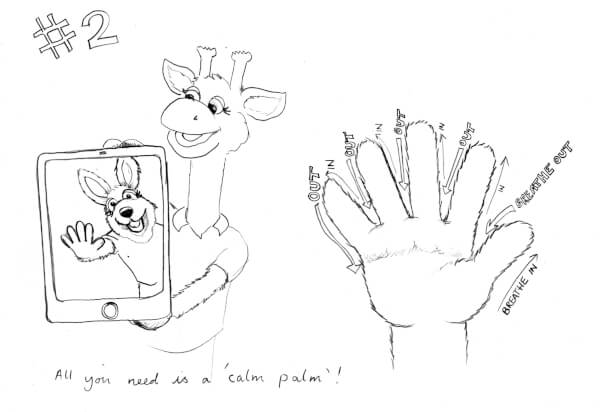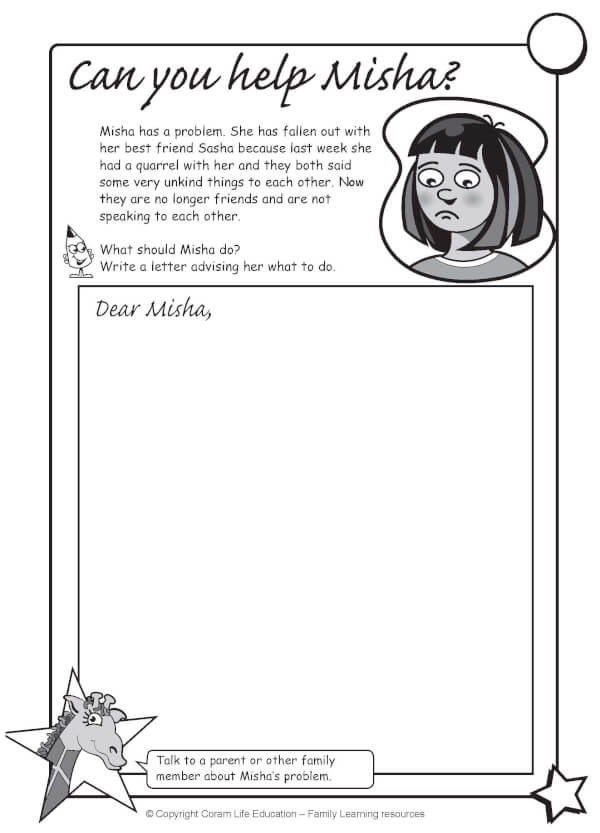At home with SCARF - Activities for 7 to 9 year-olds
What your child will be learning about
- Friendship
- Getting on with others
- Healthy relationships
- Listening to feelings
- Understanding other people’s feelings
- Assertive skills
What your child can think about - or for you to talk about, together
- What helps me to get on with my friends?
- How can I be a good friend and look after my friends?
- How can I tell how someone else is feeling so that I can understand their actions?
- How can I be a good listener?
- What should I do if a friend asks me to do something that I don’t think is a good idea and that might be risky?
What your child can do - together with you or independently
Activity 1- Looking after my special people
(Can be done with an adult helper, or alone)
Think about someone who is special to you, then talk about this person with your adult helper - or if you’re doing this by yourself write down your ideas. Use these questions to get you started:
- What is it that makes you feel good about your special person?
- What do we do to make our special people happy?
- How do we feel if we fall out with them?
- What sort of things do we do to make up with them?
Make a thank you card for your special person. If you don’t have any card, you could use paper. Write a message to your special person. Here’s a starter for you "You are special to me because…"
Activity 2 - Reading someone's feelings
Look through newspapers (this could be online, with safe settings on your device) or magazines and try to guess how a person is feeling from their body language - e.g. from their expressions or how they are standing.
Next, play this game with a family member: make a list of 5 different feelings. Write these on separate, small pieces of paper.
Now fold up the pieces of paper and put them into a bowl or other container - there should be 10 in total.
Take turns to pick out one of the pieces of paper and read it, without the other person seeing what’s on your paper. Next, act out the feeling that’s on your piece of paper. How quickly can your partner guess the right answer? Take turns until all the pieces of paper have been used.
Try again - this time with some different feelings.
Activity 3 - A feelings dictionary
If we can recognise feelings that we have it can help us to manage them. Lots of feelings come with physical signs in our body. These will be different for different people. Here are some examples:
Feeling nervous:
- butterflies in the tummy
- sweaty palms
- dry mouth
On a piece of paper, draw a gingerbread person or a stick person. Next, write some of the physical signs that can come with one of this list of different feelings. You can choose one, or do all four and make a feelings dictionary booklet!
- Nervous
- Excited
- Angry
- Bored
If someone is free to help you think about this, try this...
Talk for a few minutes about the things you can do to help you feel ok if you have unhappy feelings. Here's an example:
If I'm feeling nervous, I can:
- take slow deep breaths, counting to four as you breathe in and to four as you breathe out
- do some de-stressing exercise like skipping or running
- to one of my special people
Try Harold the giraffe's 'Calm Palm' idea for helping to calm down if you're feeling frustrated or upset...

Trace a finger from one hand around the edge of all your fingers on your other hand - just link in the drawing. Do this slowly! Every time you trace upwards, breathe in deeply. Every time you trace downwards, breathe out slowly. After five slow breaths you should be feeling a bit calmer!
Being a good friend also means helping our friends when they are feeling sad, nervous of worried.
Try this activity, all about helping someone who's sad...

(Click on the image to make it bigger or to print.)
If you don't have a printer, just write your letter on a piece of paper.
Activity 4 - Dares and friendships
This activity is about how to manage dares in groups of friends.
If you're doing this with an adult helper, start with a conversation - share some stories about a time when friends have done risky things and encouraged others to join them.
Next, make a list of all the things that someone can do to avoid doing the risky thing that their friends are asking them to do.
Here are some examples to get you started:
- Make an excuse up - e.g. "I’ve got to go home early tonight because I’m helping to make tea."
- Suggest another activity "I’ve got an idea! Let’s get a football and have a game."
- Explain why you don’t want to do the risky thing and stand firm "I don't think it’s safe. I’m not going to do it."
Try this…
Either act out your scenarios with someone at home, practising to get out of the tricky situation
Or draw the story as a cartoon. Make sure that you succeed in avoiding the risk in your story.

